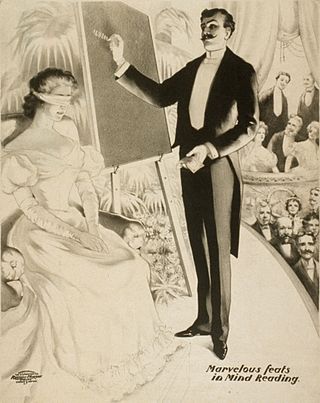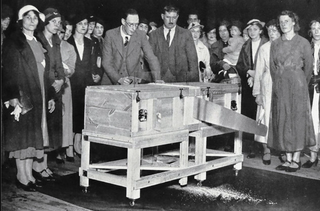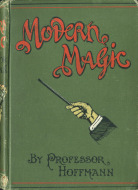
A grimoire is a textbook of magic, typically including instructions on how to create magical objects like talismans and amulets, how to perform magical spells, charms, and divination, and how to summon or invoke supernatural entities such as angels, spirits, deities, and demons. In many cases, the books themselves are believed to be imbued with magical powers, although in many cultures, other sacred texts that are not grimoires have been believed to have supernatural properties intrinsically. The only contents found in a grimoire would be information on spells, rituals, the preparation of magical tools, and lists of ingredients and their magical correspondences. In this manner, while all books on magic could be thought of as grimoires, not all magical books should be thought of as grimoires.

Magic, sometimes spelled magick, is an ancient practice rooted in rituals, spiritual divinations, and/or cultural lineage—with an intention to invoke, manipulate, or otherwise manifest supernatural forces, beings, or entities in the natural world. It is a categorical yet often ambiguous term which has been used to refer to a wide variety of beliefs and practices, frequently considered separate from both religion and science.

Jean-Eugène Robert-Houdin was a French watchmaker, magician and illusionist, widely recognized as the father of the modern style of conjuring. He transformed magic from a pastime for the lower classes, seen at fairs, to an entertainment for the wealthy, which he offered in a theatre opened in Paris, a legacy preserved by the tradition of modern magicians performing in tails.
Thaumaturgy is the purported capability of a magician to work magic or other paranormal events or a saint to perform miracles. It is sometimes translated into English as wonderworking.

The cups and balls is a performance of magic with innumerable adaptations. Street gambling variations performed by conmen were known as Bunco Booths. A typical cups and balls routine includes many of the most fundamental effects of magic: the balls can vanish, appear, transpose, reappear and transform. Basic skills, such as misdirection, manual dexterity, sleight of hand, and audience management are also essential to most cups and balls routines. As a result, mastery of the cups and balls is considered by many as the litmus test of a magician's skill with gimmick style tricks. Magician John Mulholland wrote that Harry Houdini had expressed the opinion that no one could be considered an accomplished magician until he had mastered the cups and balls. Professor Hoffman called the cups and balls "the groundwork of all legerdemain".

Card manipulation is the branch of magic that deals with creating effects using sleight of hand techniques involving playing cards. Card manipulation is often used in magical performances, especially in close-up, parlor, and street magic. Some of the most recognized names in this field include Dai Vernon, Tony Slydini, Ed Marlo, S.W. Erdnase, Richard Turner, John Scarne, and Ricky Jay. Before becoming world-famous for his escapes, Houdini billed himself as "The King of Cards". Among the more well-known card tricks relying on card manipulation are Ambitious Card, and Three-card Monte, a common street hustle also known as Find the Lady.

Coin magic is the manipulating of coins to entertain audiences. Because coins are small, most coin tricks are considered close-up magic or table magic, as the audience must be close to the performer to see the effects. Though stage conjurers generally do not use coin effects, coin magic is sometimes performed onstage using large coins. In a different type of performance setting, a close-up coin magician will use a large video projector so the audience can see the magic on a big screen. Coin magic is generally considered harder to master than other close-up techniques such as card magic, as it requires great skill and grace to perform convincingly, and this requires much practice to acquire.

Mentalism is a performing art in which its practitioners, known as mentalists, appear to demonstrate highly developed mental or intuitive abilities. Performances may appear to include hypnosis, telepathy, clairvoyance, divination, precognition, psychokinesis, mediumship, mind control, memory feats, deduction, and rapid mathematics. Mentalists perform a theatrical act that includes special effects that may appear to employ psychic or supernatural forces but that are actually achieved by "ordinary conjuring means", natural human abilities, and an in-depth understanding of key principles from human psychology or other behavioral sciences.

Sawing a woman in half is a generic name for a number of stage magic tricks in which a person is apparently cut or divided into two or more pieces.
The bullet catch is a stage magic illusion in which a magician appears to catch a bullet fired directly at them — often in the mouth, sometimes in the hand or sometimes caught with other items such as a dinner plate. The bullet catch may also be referred to as the bullet trick, defying the bullets or occasionally the gun trick.

Street magic falls into two genres; traditional street performance and guerrilla magic.
The Indian rope trick is a magic trick said to have been performed in and around India during the 19th century. Sometimes described as "the world’s greatest illusion", it reputedly involved a magician, a length of rope, and one or more boy assistants.
This timeline of magic is a history of the performing art from B.C. to the present.
A magician's assistant is a performer in a magic act who is not billed as the magician or principal name in the act.
The Bamberg Magical Dynasty were a Dutch family of magicians, consisting of six generations of Bambergs. The Bambergs were an upper middle-class unorthodox Jewish family. The oldest sons were also magicians and carried on the tradition. This tradition was not always exclusive to just the oldest son; Theo Bamberg's two younger brothers also carried on the family tradition. Three Bambergs were court magicians entertaining the royal family. This chain was unbroken for 165 years, from the 18th to the 20th centuries.

Magic, which encompasses the subgenres of illusion, stage magic, and close up magic, among others, is a performing art in which audiences are entertained by tricks, effects, or illusions of seemingly impossible feats, using natural means. It is to be distinguished from paranormal magic which are effects claimed to be created through supernatural means. It is one of the oldest performing arts in the world.

Modern Magic by Professor Hoffmann is a treatise in book form, first published in 1876, detailing the apparatus, methods and tricks used by the magicians and conjurors of that era. Hoffmann was considered to be one of the greatest authorities on the theory and practice of magic, despite his own limited professional experience as a magician.
The Inexhaustible Bottle is a classic magic trick performed by stage magicians. It dates to the 17th century and has since inspired many variations; well known examples include Any Drink Called For, The Bar Act, Satan's Barman, the Assassin's Teapot and Think-a-Drink. During the temperance movement it became The Obliging Tea Kettle, and the modern Magic Tea Kettle remains a common prop available at most magic stores. A slight variation is the Magic Funnel. Today, the trick is normally performed for children, although some stand-up shows retain a variation.
The blow book, better known as a magic coloring book in modern variations, is a classic magic trick that has been performed for hundreds of years. It was most popular from the 16th to the 19th century, when variations of the concept were a staple of the book publishing trade. It has been referred to as the oldest example of a manufactured prop used for magic. It remains a common trick today, albeit mostly performed for children, preferably at birthday parties or other events due to the visual nature of the illusion.
Jamie Allan is a United Kingdom-based magician. He is known for the fusion of magic and technology. Jamie Allan performs modern illusions with iPads, Laser Beams, Facebook and Twitter. He has appeared on various TV shows and has worked alongside various other entertainers and performers and designed illusions and effects for them. He has also worked in many aspects of the entertainment industry, as performer, producer, writer and director. He is Creator and Co-Writer of the musical Houdini.









